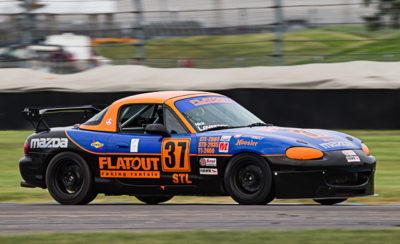Nick Leverone’s Super Touring Lite Miata is prepped to the limit
Super Touring Lite is becoming one of SCCA’s most popular classes, and was the third largest at the 2017 SCCA Runoffs at Indianapolis Motor Speedway. It is also one of the most varied, with a tremendous number of different models serving as bases for STL cars, and a wide variety of approaches to building them. Nick Leverone’s NB Miata is one of three unique approaches to building a Mazda STL car that we’ll explore. Leverone was the top finishing Mazda driver at the Runoffs and won several SCCA U.S. Majors Tour races this year.
“I don’t think we spared anything on it,” says Leverone, who is one of the principals of Massachusetts-based Flatout Motorsports. Flatout builds and preps cars, along with renting a variety of racing machinery. “It’s built to the limit of the rules – suspension, engine, driveline, aero…whatever we could do to make the car faster, we’ve done to it. We developed a lot of the pieces in-house – the chin spoiler, the splitter on the front, the header. We’ve done some stuff in the water pump area that we are allowed to do that I don’t think some other people are doing quite yet. They may find out soon enough that they can find some power there.”
There are few areas of development Leverone hasn’t explored. “At this point, I’m not really sure there is anything,” he says. “The guys at the front of the fields, they’ve pretty much maxed out everything they can do with the cars. And I think things are close. There may need to be a little bit of tweaking.”
That includes aerodynamics, which can play a big part in the fast corners, even if the allowed wings and splitters aren’t particularly large.
“You can really feel it in high-speed braking and high-speed corners like 80mph-plus corners. Below that, I don’t think it’s really helping us all that much or has killed us down the straightaways. But for sure in fast corners it’s working and definitely in the braking zone. You get a 126mph straightaway and when you hit the brakes, you can feel it suck the car down to the ground, which is a good feeling,” he says.
While it’s generally acknowledged that the Mazdas are at a power disadvantage to some of the competition in STL, Leverone says he feels the rear-wheel-drive platform is better balanced and leaves the driver with more tire at the end of a race, especially since the class is pretty tire-limited. He also feels the Mazdas have a handling advantage.
“The balance of the car through the corners is better. It’s tough when you’re trying to do 75 percent of the work with two of your tires. The balance between front and rear is much better in a rear-wheel-drive car. I hope that advantage shows at the end of a race when their front tires may be melted.”
Leverone won Majors races at Homestead, Sebring, COTA, NOLA and VIR. He finished sixth at the Runoffs, the highest-placing Mazda.
“I think all the pieces we developed have made the car able to do what it can do, which is why it won a lot of races this year. The car was pretty dominant for most of the year. But there are some really fast guys out there with some really fast cars,” he says.
In the coming weeks, we’ll take a look at a couple of other approaches to making fast STL Mazdas that Leverone has had a hand in, including a fast NC and a rotary-powered NB.


 ACCESSIBILITY
ACCESSIBILITY